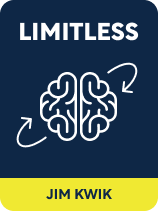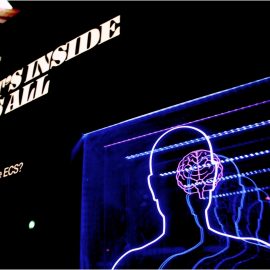

This article is an excerpt from the Shortform book guide to "Limitless" by Jim Kwik. Shortform has the world's best summaries and analyses of books you should be reading.
Like this article? Sign up for a free trial here .
What drives you? What motivates you to do big things in life?
When you have a limitless mindframe, you understand that you can accomplish more than you ever thought was possible. However, believing that you can do incredible things is only the first step. The next is to figure out what you actually want to do. In other words, you have to find what drives you.
Keep reading to learn where you should look in order to discover what drives you.
Discover What Drives You
According to Limitless author Jim Kwik, knowing what drives you is a matter of identifying four things:
1. Your purpose: What you do. In other words, what are your goals in life, and how will you work toward them?
| In The Monk Who Sold His Ferrari, Robin Sharma suggests finding your purpose by keeping a Dream Book: Write down goals from all different areas of your life (health goals, relationship goals, career goals, and so on). Keep the goals separated by category. Also include pictures that represent your goals, or pictures of people who have reached those goals. For example, if your goal is to lose weight, perhaps include a picture of an athlete or model. Periodically look through your Dream Book. Ask yourself which types of goals you’re excited to work toward, and which seem to come easily to you. Finding goals that you’re naturally inclined to work toward is a big step toward finding your purpose in life. |
2. Your passion: Why you do what you do. In other words, what gets you excited? What makes you want to work?
- Purpose and passion are closely linked. Knowing what you’re passionate about will help you to find your purpose in life; having a clear purpose will allow you to live and work passionately. Your passion is part of what drives you.
| Counterpoint: Design Your Passion Designing Your Life argues that passion isn’t something you find; it’s something you create by carefully planning and building the kind of life you want to live. Doing so requires a major shift in thinking—going from a mindframe of “find your passion and everything will work out” to a mindframe of: Curiosity: Asking who you want to be, and what kind of life you want to live. Experimentation: Trying new things, seeing what resonates with you and what doesn’t. Reframing: Rethinking old, harmful beliefs—these could be anything from thinking that there’s a “perfect” life waiting for you to find it, to thinking that you can sum up your identity with a simple label (“business owner,” “artist,” “parent,” and so on). Focusing on the process: Taking your experiences as they come; focusing on what you’re doing at the moment, rather than on some far-off goal that you hope to reach someday. Teamwork: Recognizing that you can’t design or build a life on your own; seeking help and support when you need it. Designing Your Life asserts that passion is the result of a fulfilling life, rather than the cause of it. |
3. Your reasons: Your reasons are like your passions, but much more specific. They also are part of what drives you. Your reasons are what get you up and working at any given moment, especially when you’d rather be doing something else. For example, someone might become a veterinarian because she’s passionate about animals; however, the reason that gets her to work each day might be that she’ll have a chance to save someone’s beloved pet.
| Our Reasons Come From Pleasure and Pain In Awaken the Giant Within, Robbins says that all of what drives you—which is to say, your reasons for what you do—boil down to two things: seeking pleasure and avoiding pain. According to Robbins, all of the more complex motivations (like the vet who goes to work each day to save people’s pets) come from pleasurable or painful associations created in the mind. For example, perhaps the vet feels a thrill or a sense of great satisfaction when she’s able to save an animal’s life. Those are pleasant sensations that she associates with her job, so she continues doing her job in order to experience those sensations. Furthermore, Robbins says that if you want to do something but are having trouble finding the motivation to do it, you probably have conflicting associations. To continue with the vet example, if she has trouble getting going in the morning, it may be that the pleasure of helping pets is conflicting with the pain of another tiring day dealing with demanding human customers. |
4. Your values: Values are about who you are as a person, and they are part of what drives you. In other words, what’s truly important to you? Also, Kwik notes that you must recognize whether each value is a means value or an end value—in other words, is your value just a step toward something else, or is it an end in itself? For example, “popularity” is a means value; it doesn’t achieve anything on its own. The end value it’s working toward might be “acceptance,” “belonging,” or “confidence.”
| Find Your Values It seems like understanding your own values should be easy, but that’s not always the case. Sometimes we value things without realizing it—especially if those values are selfish, like valuing popularity or control. We often hide such unconstructive values from ourselves in order to protect our self-image. In The Subtle Art of Not Giving a F*ck, Mark Manson suggests finding your values by starting from your emotions: Identify your emotions. When something sparks a strong emotional response in you, observe that reaction. What are you feeling at that moment? Determine why you feel them. Ask yourself why you feel the way that you do. You may find it helpful, or even necessary, to keep asking “why” about each response that you come up with—eventually you’ll reach a point where you can’t answer the “why,” or your answer will be something along the lines of “just because.” That will be the core reason for the emotions you felt. Identify the underlying values. Once you know the reason for the emotional response, you can determine what values you were using to gauge the situation. For example, if you lost a game against your child and felt angry or frustrated about it, that might be because you were valuing “winning.” If you felt proud and satisfied, it might be because you were valuing your child’s accomplishments. Manson believes that our thoughts and feelings are ultimately rooted in our values. Therefore, by working backward from our feelings, we can determine what our values actually are, and change them if necessary. |
Set SMART Goals
Kwik believes that, by setting good goals for yourself, you’ll naturally create your own motivation to reach them. To help guide your goal-setting process, he suggests following the practice of many businesses and using the acronym SMART:
- Specific: Make sure your goal is clear and well-defined.
- Measurable: Make sure you have a way to track your progress, and to know when you’ve reached your goal. Measurable may overlap with specific.
- Actionable: Make sure there are clear and specific steps you can follow to reach your goal.
- Realistic: Your goals should be challenging, but not impossible. Don’t pick something that you’ll get discouraged with.
- Time-based: Giving yourself a timeframe for your goals serves two purposes: It spurs you to work toward those goals, and it gives you a heads up if you’re not on track to reach them.
| Even if your goals meet all of Kwik’s criteria, you might still find yourself struggling if external forces have too much influence on them. In Awaken the Giant Within, Tony Robbins adds a couple of other qualities that good goals should have: Controllable. Make sure that your goals don’t rely on other people or outside forces doing what you want them to. For example, “becoming popular” wouldn’t be a good goal, because it relies upon other people deciding that they like you. Flexible. Robbins says that you should always be ready to adjust your goals, as well as your plans to achieve them. Robbins also echoes Kwik’s point that having meaningful, challenging goals is an effective way to create motivation for yourself. |
Add up your purpose, passion, reasons, and values, and you’ll have a clear idea of what drives you.

———End of Preview———
Like what you just read? Read the rest of the world's best book summary and analysis of Jim Kwik's "Limitless" at Shortform .
Here's what you'll find in our full Limitless summary :
- Jim Kwik's guide to meta-learning: learning how to learn
- How to quickly and effectively learn about any topic
- How to use your new knowledge to its maximum potential






